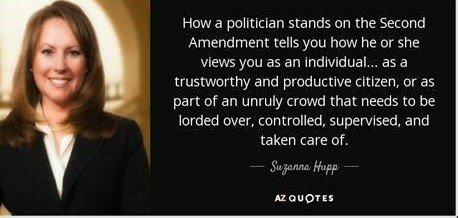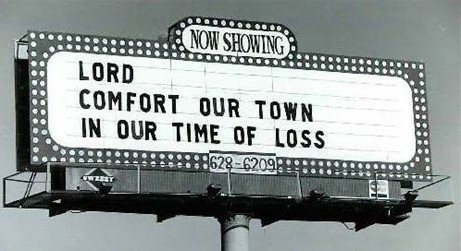The October 1991 Rampage Left 23 Dead, Dozens Injured in a Central Texas Restaurant

Luby’s has been a popular Texas cafeteria chain first opened by Bob Luby in 1947 in San Antonio.
The restaurant company, now based out of Houston, had been dealing with disappointing financial results long before the pandemic of 2020 hit. Recently, they’ve been selling much of their assets and real estate for a pending buyout from investors.
Located mostly throughout Texas, there has been some Luby’s restaurants in Arkansas and Mississippi.
On National Boss’s Day, Wednesday, October 16, 1991, I received a phone call not long after noon from Greg Weaver a maintenance tech with H-E-B Food/Drugs. Greg was on his way to lunch at a Luby’s but stopped for gas at a nearby convenience store to call me from Killeen, Texas.
I was Director of Facilities Management for H-E-B and Greg had some questions and information he wanted to run past me before he ate.
“Damn, can you hear that?” Greg asked during the conversation. I couldn’t, but he said it sounded like “a bunch of commotion, like gun shots nearby.”

We commenced to talking and moments later he said there were “police and ambulances coming from all over the place. It looks like I won’t be eating at Luby’s after all. Apparently something bad happened over there.”
After we completed our conversation, I attempted to call an old high school friend and college roommate, Gerald Farris.
Jerry was the Vice President of Loss Prevention for Luby’s so I thought he may have heard something about Killeen.

There was no way I was going to speak with Jerry that day. Can you imagine what his role was like in the aftermath of the deadliest public massacre in American history at the time?
Greg Weaver called back to provide more details about a gunman who crashed his pickup into the front of Luby’s and proceeded to open fire.
“Nope, I’ll will not be eating there,” Weaver said. “It’s all blocked off. Something big happened.”
My office staff monitored radio and television news for information. It was probably 15 or 20 minutes after Greg called before tidbits were being announced publically.
There were about 140 lunchtime diners at that Luby’s location at 1705 East Central Texas Expressway at 12:39 p.m. when a man, later identified as George “Jo Jo” Hennard drove his blue 1987 Ford pickup truck through the restaurant’s plate glass front window.

Startled, diners naturally thought the crash was an accident and started toward the truck to help. But Hennard emerged, shouting “All women of Killeen and Belton are Vipers! This is what you’ve done to me and my family! … This is payback day!”
Armed with two semi-automatic pistols, a Glock 17 and a Ruger P89, Hennard began shooting customers and employees. His attack killed 23 people and wounded 17 others.
After police arrived, Hennard engaged in a brief shootout with officers. Wounded twice in the abdomen by police bullets and running low on ammunition, he ran into a back restroom, shot and killed himself.

Hennard was a native of Pennsylvania, the son of a Swiss surgeon. His family later moved to New Mexico, where his father worked at the White Sands Missile Range near Las Cruces.
In an interview with The New York Times a local Killen area shop clerk, Mary Mead, described Hennard’s general demeanor and the difference in him just prior to his rampage:
“George never smiled when he came in here. He just seemed like he had the world on his shoulders. He was a loner. He never talked. But yesterday he seemed almost calm, even a little friendly, for the only time I can remember. Usually, I was scared of him.”
Mead had cause to know Hennard on a passing basis as he bought breakfast at her workplace, six days a week.

Others describe him as combative, impatient, rude, troubled and a loner. One occasional drinking buddy, Tom Snyder, described him as particularly obnoxious when drunk. In brief, George Hennard was never a people person.
Hennard was 35 years old at the time of the shootings, his birthday was just the day before the massacre. He was unemployed and down on his luck. The son of a housewife and retired Army officer, Hennard had previously served two years with the U.S. Navy, gaining an honorable discharge before joining the Merchant Marine in 1977.
His discharge from the Merchant Marine in May, 1989 was less than honorable. He lost his place aboard ship when marijuana was found in his room while his ship was docked in Oakland, California.

A second drug bust cost him his seaman’s papers without which working at sea, the only job he seemed happy in, was no longer open to him.
His bitterness progressed as he became more noticeably rude and difficult around people in general. The loss of his job signalled the beginning of his own decline.
Colleagues aboard ship were relieved to see him gone. As much as Hennard enjoyed life at sea, his shipmates didn’t seem to enjoy sharing a ship with him. Speaking to The New York Times, Ike Williams, port agent for the national maritime union in Wilmington, California, summed up Hennard’s behavior towards his shipmates:
“He was very loud and he appeared to be combative at times. He would come in with a very cold look and be very argumentative, loud, boisterous, sometimes cursing and swearing.”
In February, 1991, eight months prior to his mass murder binge at Luby’s, Hennard’s attempt to regain seagoing status was denied.

Hennard began planning and preparations for seeking his revenge. He took a trip to the town of Henderson, Nevada, near Las Vegas, where he visited Mike’s Gun House owned by Michael Buchanan. There he purchased two pistols and plenty of ammunition. Despite his having a history of drug abuse, he had little difficulty in purchasing his weapons. That ease of purchase would soon cost many innocent people their lives.
Hennard spent his time between buying his guns and committing his massacre unemployed, living at his mother’s house in Benton, near Killeen.
Others that knew him later described Hennard as reclusive and belligerent. He also had an explosive temper. A former roommate said that he hated blacks, Hispanics, and gays. He also hated women, often calling them “snakes.” Survivors of the attack at Luby’s reported him passing over men to shoot women, calling at least two of them “bitch” before pulling the trigger.

After crashing into the front windows at Luby’s, Hennard, carrying Glock 17 and Ruger P89 pistols with plenty of spare clips, methodically strolled the cafeteria where diners began scrambling to avoid the onslaught.
Survivors said that as he roamed around the dining room, Hennard was deliberately intent on killing women, frequently passing over men who were equally at his mercy.
Forensic experts noted he selected his targets with more care than the typical lone gunman, many of whom simply kill anybody who appears in front of them.
He also went largely for shots most likely to be fatal — 10 of the 23 people killed were murdered with gunshots to their heads rather than Hennard aiming randomly. With seemingly total focus on killing as many people as possible, he encircled the cafeteria like a stalking predator, picking his targets, killing with an almost automatic precision and absolute ruthlessness.

The first victim was local veterinarian Michael Griffith who originally jumped up and approached the crashed pick-up to offer assistance, believing this was simply an accident.
Among the first to be wounded (and both of whose parents died in the shooting) was Suzanna Hupp, later to become a Republican member of the Texas House of Representatives and an opponent of gun-control legislation.

Hupp normally carried a .38 revolver in her purse, but had left the weapon outside in her car. She’d left her gun outside to avoid breaking strict Texas rules at the time of the shooting, rules expressly forbidding carrying concealed firearms in a public place.
When she most needed her gun, it was outside and entirely out of reach. Her father charged Hennard and was fatally shot. Her mother was murdered cradling her dying husband.

Customer Tommy Vaughn managed to evade the gunfire. Throwing a table through the windows, he created an escape route for himself and many others in the cafeteria while Hennard continued methodically picking his targets, aiming and firing his guns with an almost-military precision.
More victims rapidly followed. Hennard repeatedly emptied and reloaded his pistols with fresh clips, intent on causing the maximum carnage. Loading, aiming, firing and reloading he left bodies and dozens of spent cartridges littered the floor. The cafeteria rapidly reeked of cordite fumes tainting the afternoon air.

Panic-stricken diners hid behind chairs and under tables, intent on avoiding the bullets flying in all directions as Hennard wreaked havoc.
Hennard fired at arriving officers and they fired back. Seriously wounded in the exchange, he retreated into a restroom and shot himself in the head. At 12:52 p.m., only 13 minutes after the assault began, he was dead.
He left behind 43 dead and wounded customers. Women were the principal victims of Hennard’s rampage. Of the 23 people killed, 14 were women and nine other women were wounded. The men shot by Hennard were seemingly an afterthought and he didn’t injure any minors.

Subsequent investigations by local police uncovered Hennard’s obsessions with serial killers and a particular obsession with a song by rock band Steely Dan entitled “Don’t Take Me Alive,” a song about a violent criminal engaging in a last stand against law enforcement.
The owner of the record store where he bought the album described Hennard as unable to cope with his place in life, having lost his career and harboring an apparent desire to be remembered for something, regardless of what it might be. The store clerk also described Hennard as having a particular obsession with “Don’t Take Me Alive.” Lyrics include:
“A man of my mind can do anything…Here in this darkness I know what I’ve done, I know all at once who I am.”
Police also discovered a 1989 calendar at Hennard’s home. Remarks scrawled on the calendar included: “They shall live with what they have created and they shall find no redemption in what they have done.”
His final remark was: “There is simply no hope and not a prayer.”

Police also found two videos.
🔹One was a documentary on the destruction of Pan Am Flight 103 during the Lockerbie bombing of 1987.
🔹The other was on serial killers and mass murderers including James Huberty’s massacre in a San Ysidro McDonald’s near San Diego, California massacre, similar to Hennard’s own crime.
Sexism and Prejudice
Hennard’s misogyny is revealed to by two events, one prior to the massacre and his actions during it.
Before the shootings he had stalked two local teenagers whose names he didn’t know. They lived near his mother’s home in Benton. He went so far as sending the two young women a letter praising their individual “virtues” but stating that: “All women of Killeen and Belton are vipers!”
No evidence was ever discovered for his having any other motive than a hatred of women and pent-up bitterness and rage at the world in general and his own place in it.

The precise reason for his hatred of women is also unclear, although it’s often the mode of operation for people like Hennard who are seldom popular with the opposite sex and often bitterly resent the fact.
Famed FBI profiler and author John Douglas agrees with the idea of a lone gunman looking for revenge upon a society he despises. In a “48 Hours” documentary Douglas, one of the pioneers of criminal profiling, described those who engage in mass murder:
“They have a long history of personal life failings. They want to manipulate, dominate, control somebody because they feel that this insignificant nobody (meaning themselves) has been manipulated, has been dominated and controlled for his or her life and now ‘Here’s my opportunity to dish it out. I can call the shots, I can make the decision whether this person will live or die with just a snap of my fingers.'”

According to Northeastern University Sociology Professor Jack Leven there are several criteria under which mass murderers are most likely to act.
🔹First is frustration. Life isn’t going their way, they’re not getting breaks and opportunities that they feel they deserve and are entitled to. The fact that others seem to be getting those breaks and opportunities, in Leven’s view, while the mass murderer is not, tends to fuel their personal fire.
🔹Second is isolation, a resentment of the fact that they don’t feel themselves a part of mainstream society. They feel rejected, frustrated and bitter. They act methodically, often planning their crimes over a long period, picking out a potential target and planning thoroughly.
🔹Third is loss. It can be loss of status, of a particularly cherished job, a bereavement, things that breed upset and emotional turmoil in most of us, but seldom to a degree where suicide or mass murder become an option.
Leven argues that it was Hennard’s own personal demons that led to the Luby’s massacre. Hennard selected women as his particular target while others have been indiscriminate or selected for alleged political motives or ethnicity and/or religion.

A common thread is that, while they may particularly hate a particular group or groups within society, spree killers like George Hennard are fuelled by resentment, rage, declining personal fortunes, an inability to deal with life as it stands and an equal inability to look to their own personal deficiencies and failings. They prefer to believe that their misfortunes are the fault of their victims, denying most or all blame that might be better directed at themselves
Aftermath
Luby’s reopened on the site five months after the shootings. On a business trip through that area, Richard Martin–Greg Weaver’s supervisor at the time–decided to dine at the restaurant.

“This gives me the creeps,” Martin noted. “They have a clown greeting people, but all I can think of is John Wayne Gacy. It’s been remodeled and their intentions are good. I just can’t can get the thought of what happened here. The restroom where he (Hennard) killed himself is especially haunting?”
Richard was right.
Luby’s closed the location permanently on September 9, 2000. When I went through Killeen in 2020, the location was home to a Chinese-American buffet.
A red granite memorial to the massacre victims sits behind the Killeen Community Center.
___________________________
Please Support These American Owned Businesses
___________________________
Get Your Natural Vitamins A & D from the Sea!

___________________________










